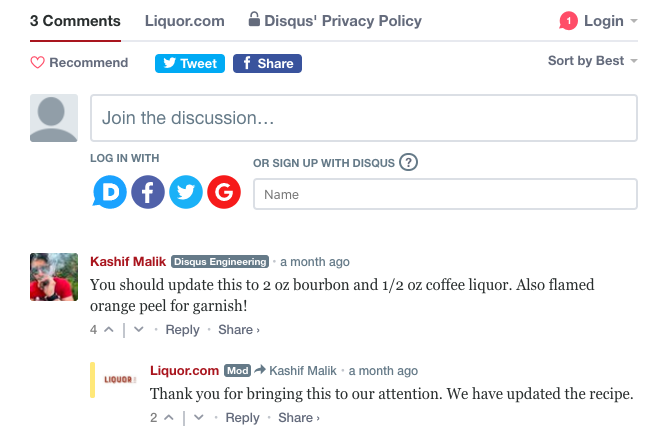
How to Engage Your Audience on Your Blog and Beyond
How to Engage Your Audience on Your Blog and Beyond
Sabra Mwaura, Marketing Director • Disqus • February 2, 2021

Have you ever spent hours working on a blog post — writing multiple drafts, editing and then editing again, and creating graphics — only to hit “publish” and hear … crickets?
No comments, low page views, hardly any social shares, and sometimes not even hearing from your parents or friends can be discouraging. Today, that changes. We’re going to discuss the ins and outs of how you can get a reader’s attention and create engagement on your blog and beyond!
1. Choose the Right Topics
First things first, you have to know what your audience wants to read about. The blog posts that garner the most engagement answer audience members’ burning questions or solve a big problem they’re facing. So why not directly ask them what they want to read about?
Here are a few tried-and-true tips you can use to find out what your audience wants to learn from you:
-
Ask on Instagram Stories.
Instagram Stories has a question feature, so if you have an engaged audience there, you can create a post asking your followers for feedback or ideas. For example, you could post a question asking, “What would you like to learn about in our next blog post?” and have your followers respond with precisely what’s on their minds.
You can also use the polling feature (Twitter has one, too) and ask your audience members which topic of a few choices they’d like to learn about next. This is also a great way to determine any common threads or themes that can help guide you when you brainstorm future content.
-
Survey your email list.
Another approach is to send out a survey to your email list asking what their pain points are and what they would like to learn about from your company.
You can use a free tool like Google Forms to collect survey answers. Other options include Typeform or SurveyMonkey, which both have free and paid versions.
Pro tip: Encourage your email list to participate by offering to enter respondents in a giveaway. The reward could be a gift card or a free product, and it can help boost the number of respondents. -
Search for ideas in forums.
Forums aren’t utilized nearly enough by businesses when they’re planning out blog topics. Forums like Quora, Reddit, or Disqus (my company) contain thousands of posts about a variety of topics, so they’re a great place to find content marketing inspiration.
To get started, do a search for threads related to your industry. From there, compile a list of the relevant questions you find. This can inform your content planning because you’ll have a better understanding of what kind of information people in your industry are looking for.
-
Read the comments section of competitors’ blogs and social media accounts.
Although your own comments section can be a great way to find blog post topics, you should consider looking at your competitors’ comment sections as well.
This tactic is helpful in figuring out what similar audiences hope to learn so that you can come up with helpful, relevant content ideas. Don’t spend too much time here: You want your content to be unique to your organization.
2. Utilize an Engaging Format
Now that you’ve developed an engaging topic idea based on what your audience is curious about, you can start writing! You can use many content formats, but some perform better than others. Here are three formats that might lead to more engagement from your audience:
-
How-to posts
Out of the top four most-asked questions on Google, two of them start with “how to.” And the top keyword used in voice search is “how.”
People are clearly searching for tried-and-true methods to complete tasks or improve at something, so publishing how-to posts that can increase the likelihood that your content is found in organic search results.
-
Guides
Guides perform well, too. In fact, articles that include “guide” in the title garner 10% more backlinks than other types of content. This means that other sites deem these pieces of content valuable and trustworthy and that they’re proving that sentiment by linking to those guides from their own websites.
Guides are usually longer and more in-depth like pillar posts, whitepapers, or e-books. For example, at Disqus, we published a comprehensive guide on how to increase reader engagement, which you can find here.
-
Lists
While list content, or “listicles,” might seem to be overdone, many readers still love them. Thirty-six percent of readers prefer list-based headlines. This is probably because list articles are quick to consume and easy to share. Love ’em or hate ’em, lists are often loved, and sometimes you just have to give the people what they want!
Because people enjoy engaging with list-based content, you can see some strong results when you create this type of content that covers relevant topics in an engaging way.
3. Craft an Attention-Grabbing Headline
The headline just might be the most difficult — and the most important — copy you write for your blog post. If you don’t hook readers’ attention with your headline, they won’t click through to your blog post.
Here are a few tips for writing compelling headlines:
-
Write the headline after you finish writing the article so you can clearly define the promise or give a sneak preview of what’s to come.
-
Make it clear what problem your blog post is solving.
-
Let readers in on the reward they’ll get for reading your blog post.
-
Include impactful stats when it makes sense in order to make your headline punchier.
-
Write five to 10 title options to choose from.
4. Interact With Your Audience Directly
Here’s the magic ingredient to ensure an engaged audience in the comments section of your blog or on social media: Respond to every single comment.
If you’ve enabled a comments section on your blog, take the time to respond to readers. However, you don’t need to respond to spam comments or trolls. (Platforms like Disqus can help curb spam content on your blog.)
When readers know that you consistently respond to comments and engage in a dialogue with them, they are more likely to comment and continue to engage with your content. You’ll build a two-way relationship with your audience on your platforms.
Plus, your readers sometimes have valuable nuggets of information you can add to your article. When you do that, you acknowledge how valuable they are and reward them for it. Check out a recent example from a Disqus publisher below:

Here are a few other pro tips on how you can engage with your audience directly:
-
Don’t forget to share your blog content across your social channels so you can continually engage with people who have chosen to follow your business.
-
For an extra personalized touch, send specific readers content you know they would enjoy.
-
Keep your email newsletter up-to-date by including your new blog content. Your email list will thank you for keeping them posted on new developments in your industry!
Getting your readers to engage with your content comes back to one thing: serving them and their needs. Create content that solves their pain points and keeps them informed about the topics they care about. And encourage them to interact with you by being active yourself! Share on your social channels. Respond to comments. Be there as a helpful resource and earn your audience’s trust.
